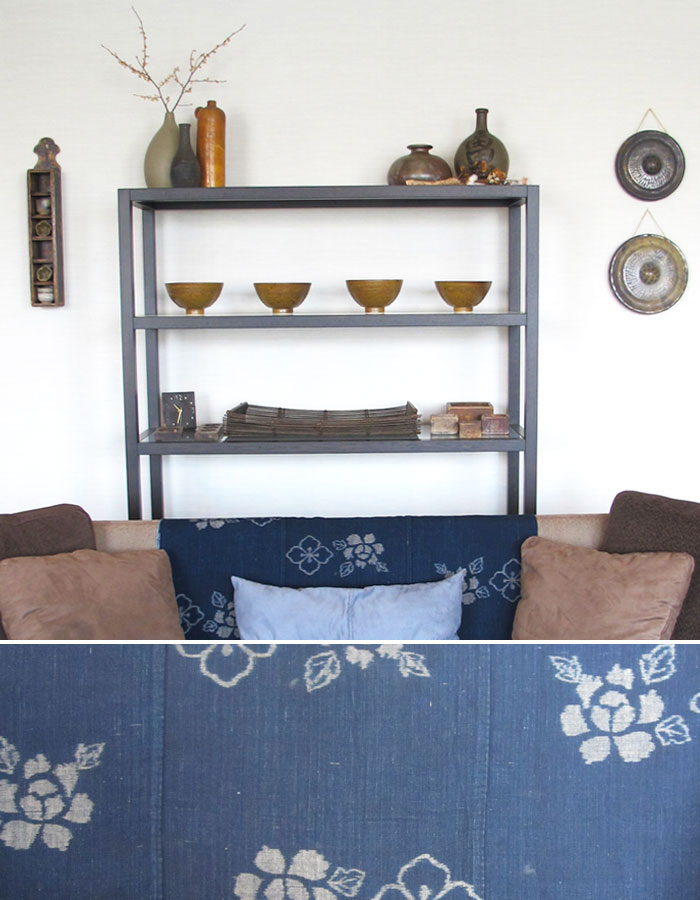I’ve shopped with and for this friend and I always know what will appeal to her. Authenticity and patina, along with a certain roughness of finish and a palette of browns, ochres, and greys, with variety picked out in texture. The photo below was meant to feature the homespun kasuri futon cover (purchased at Kawagoe), but it also highlights a very few pieces of an enormous collection of modern Japanese pottery, much of it bought up in Mashiko, the famous pottery village. Much to my chagrin, I didn’t think to photograph the insides of her cupboards – that may have to wait for some other post. Most everything else was accumulated at shrine sales around Tokyo and she is unabashed when I pick something up and say “this has your name on it!” She knows her own mind.
Heading back out to the entry way to start the tour properly, the tone is set for the entire space as you walk in. Everything shows its age, from the vintage silkworm basket hanging on the wall, to the abacus and sake jug on the rustic cabinet. And here we see the beginning of one of the motifs in this space – the juxtaposition of squares and rectangles with circles, which the owner uses over and over again to great effect.
As I was there to photograph the kasuri futon cover, the rest of the photo shoot was a bit ad hoc, so excuse wires and everyday items that would normally be put away or out of sight. The truth is, seeing spaces as they are really used is more authentic anyway.
The television wall has a great collection of Japanese baskets including a big old rectangular silkworm tray. I continue to think big baskets are a great trick for TV walls – they balance the large dark expanse of the equipment while posing no heavy threat to it. The owner is an insatiable collector of baskets, second only perhaps to pottery – she cannot resist them – adoring their texture and lightness. The use of baskets throughout the apartment is another constant motif.
A corner of the living room gives pride of place to a beat up old tansu and a beautiful still life of finely woven basket mounted with a single branch. The limited color palette, augmented only by bits of natural green and a little blue, with texture for interest, is yet a third motif in the space.
Another vignette repeats the patterns, small cabinet, fine baskets and branches and a sweet bird print tucked into a silver leafed cherry wood frame.
This arrangement on the kitchen counter has lots of my favorites, including a glass senbei canister, a vintage sieve, some old signage and more pottery.
It’s not only in Japan that the owner is so consistent. Not at all surprising to discover that she has a historically accurate and incredibly well-preserved 1830s home in Connecticut. From the outside you would never guess that parts of the house are an addition as they worked to keep a natural roofline, the kind that develops with additions over the years. The interiors blend the old and the new by using antique flooring and antique beams salvaged from an old barn found elsewhere in Connecticut. The old part of the house has all the original wide board flooring, beams, and horse hair plaster walls. The house itself is filled with Americana of the period, antique cupboards, dry sinks, blanket chests, quilts, crocks, and yes – pottery – lots and lots of pottery, but in this case classic American redware and yellowware.
Adore this winter photo but I am looking forward to seeing it this summer! And whenever it is that she moves back, I’m even more interested in seeing the dialogue between the old Japanese and American pieces. I think it will be a lively conversation.








That’s a girl after my own heart. Please tell her I absolutely adore her style. It’s nice to see another “basket case” like me too! I just so appreciate a hand woven basket no matter which country it originates from and which form it takes. Thinking of the hands that weave/wove them to the hands that use(d) them is awesome.
Simplicity seems to be her design style. It is lovely! Thank you for sharing.
Wow – those vignettes are so lovely…
never though of hanging baskets like that. she has amazing style
I hope you’ll post photos of the Connecticut home as well. Everything chosen works so well together, and I love vignettes at various levels in a room- not all on tabletops or walls.
Wonderful pieces – fabulous cohesion- nice work ladies!
joyeux